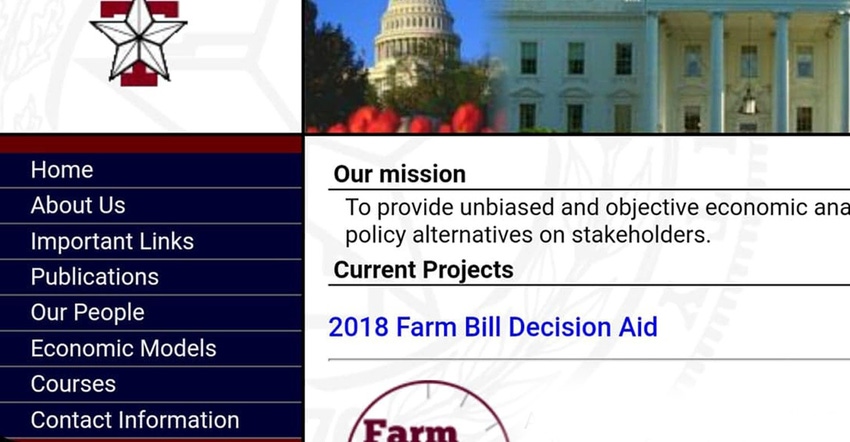
While U.S. Agriculture Secretary Sonny Perdue announced signups for the 2018 farm bill to begin Sept. 3, Texas A&M AgriLife Extension Service specialists say it may be prudent for producers to wait until the Oct. 1 sign-ups to enroll for both 2019 and 2020 crop years.
The 2014 farm bill, which covered 2014-2018, expired at the end of 2018. The new 2018 farm bill passed in December and covers 2019-2023 crop years. Because sign-ups in 2019 were delayed by the government shutdown and are only beginning this month, waiting until October will provide producers the opportunity to enroll for both at the same time.
DeDe Jones, AgriLife Extension risk management specialist, Amarillo, recently spoke at a Randall County field day and said, “Either way you should have a while. But in terms of the overall bill, this new legislation is pretty much the 2014 farm bill with a cherry on top. No new money at all.”
She said some programs are tweaked for the better, some not. Enhancements have been made to Agricultural Risk Coverage, ARC, and updated yield options are offered on Price Loss Coverage, PLC.
See, Fall meetings to offer Okla. producers farm bill insights
ARC is a “shallow loss” program that covers drops in income relative to a benchmark revenue, Jones explained, while PLC is a “deep loss” program that covers losses in income due to national price declines of a covered commodity below established reference prices.
Producers will not be allowed to update or reallocate base acres, and base acres planted to pasture or grass will no longer receive payments, Jones said. That only affects farms, where all base acres were out of production from Jan. 1, 2009, to Dec. 31, 2017, and these farms, can apply to participate in a grassland incentive contract under the Conservation Stewardship Program for $18 per acre.
Decision Tool
Dr. Justin Benavidez, AgriLife Extension economist, Amarillo, said the Agricultural and Food Policy Center at Texas A&M, or AFPC, College Station, can help producers work through their options with the 2018 Farm Bill Decision Aid.
See,
The AFPC Farm Bill Decision Aid will address two major decisions growers must consider under the 2018 farm bill, Benavidez said.
“The first decision for producers to consider is whether or not they want to update their payment yields,” he said. “The decision aid allows producers to enter their 2014 PLC payment yield, and the information associated with the chosen crop, practice, acreage and yield for that farm. The tool will use that information to calculate an updated payment yield based on the regulations in the farm bill.”
The second selection the decision aid can help address is the choice between ARC and PLC, Benavidez said. Using the higher of either the updated yield or the yield set under the 2014 bill and a preset price or a self-set projection of price, the tool will provide producers with expected payment outcomes for ARC and PLC.
Important to Remember
When using the tool, Benavidez said there are a few important things producers should remember.
See, PLC, ARC enrollment now open for 2019 election
“First, the tool is only set for the 2019-2020 crop-year decision, the first to be made under the 2018 farm bill,” Benavidez said. “Second, remember that expected payments produced by the decision aid do not account for a government sequester, payment limits or interactions with crop insurance.”
Another tweak this year is in the 2014 farm bill, says Jones, “Whatever program you picked you were stuck with for the life of the bill. That’s not the case this time.” Producers can choose either ARC or PLC for each covered crop by farm number in 2019-2020, then make changes again in 2021, 2022 and 2023.
“Given our flat prices, PLC will likely be the better program for a while,” Jones said. “I just don’t see how ARC will be that attractive.”
Improvements
Another change beginning in 2019 is ARC payments will be based on the physical location of a farm rather than the administrative county, which Jones said is an improvement over the 2014 farm bill.
Also, in the 2018 farm bill there was little change to crop insurance subsidies or payment limits. Payment limits remain at $125,000 per person, and the adjusted gross income limit to be eligible for program payments is still $900,000 per person.
There’s also an improvement in conservation programs, including a gradual increase in the Conservation Reserve Program, CRP, acreage from 24 million to 27 million acres. More money was also added to the Environmental Quality Incentive Program, EQIP, which benefits many Texas producers.
Source: is AgriLife TODAY, which is solely responsible for the information provided and is wholly owned by the source. Informa Business Media and all its subsidiaries are not responsible for any of the content contained in this information asset.
About the Author(s)
You May Also Like




